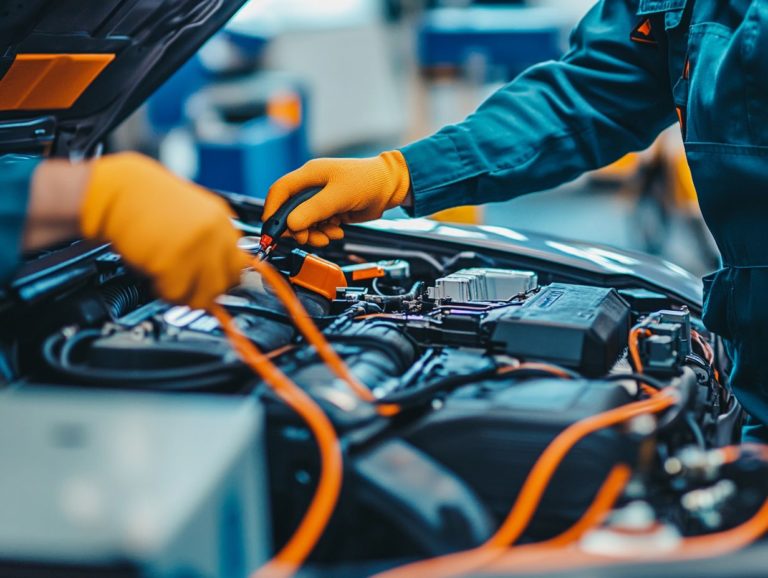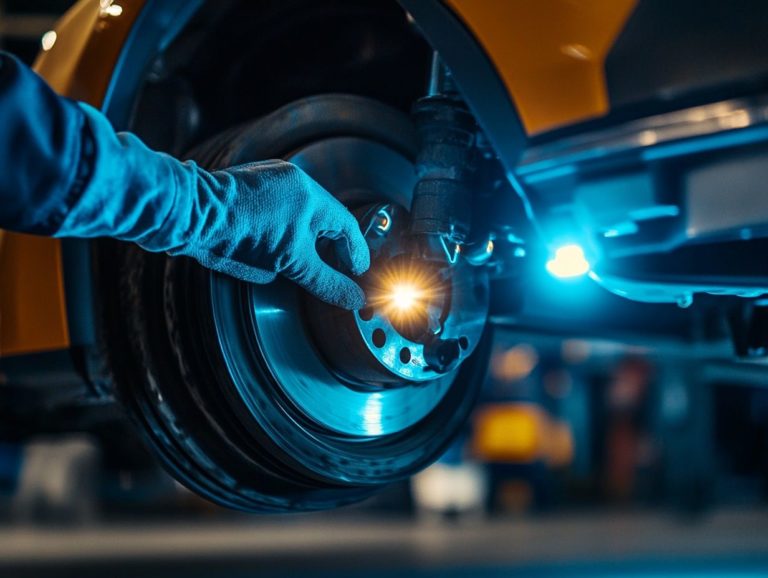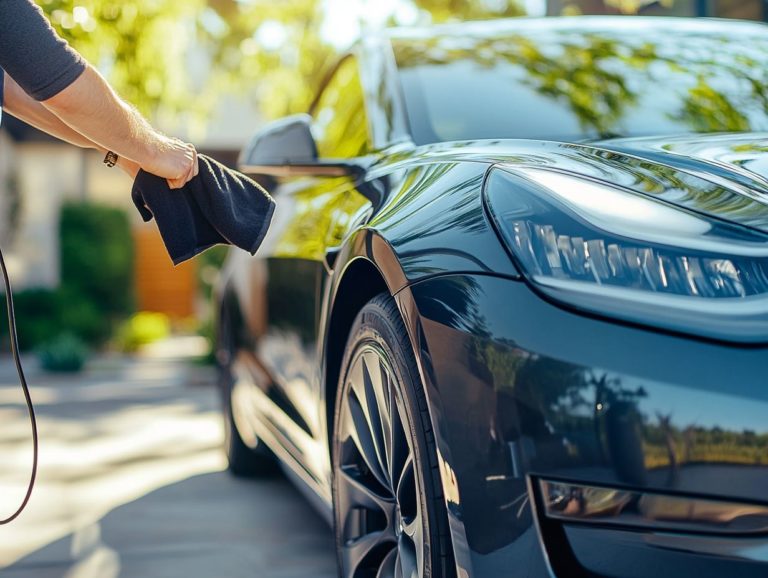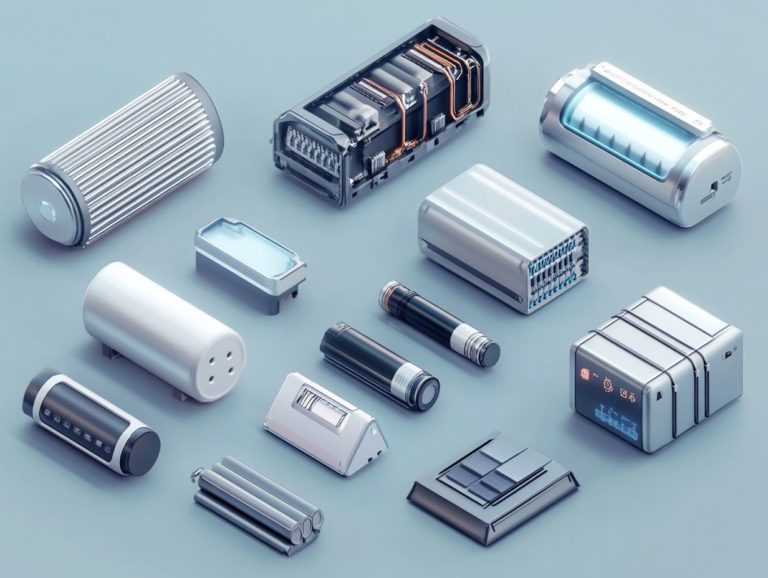Best Practices for EV Paint Protection
Electric vehicles (EVs) are more than just cutting-edge technology. They require special attention to maintain their striking appearance.
A key element of this care is paint protection. Understanding what EV paint protection involves can save you both time and money.
This guide empowers you to keep your EV looking great by exploring different protection options. You’ll also find best practices for application and maintenance.
The guide highlights common pitfalls to avoid, ensuring your vehicle stays as stunning as the day you first drove it off the lot.
Dive into these insights and discover how to keep your EV looking brand new!
Contents
- Key Takeaways:
- Understanding EV Paint Protection
- The Importance of Protecting EV Paint
- Types of EV Paint Protection
- Best Practices for Applying EV Paint Protection
- Maintaining EV Paint Protection
- Common Mistakes to Avoid
- Frequently Asked Questions
- What are the best practices for EV paint protection?
- Do I need to use a specific type of wax for my EV’s paint?
- Can I use a pressure washer to clean my EV’s paint?
- How often should I wash my EV to protect its paint?
- What is a ceramic coating and how does it protect my EV’s paint?
- Are there any special considerations for protecting the paint on my EV?
Key Takeaways:
Understanding EV Paint Protection
EV paint protection is essential for preserving both the longevity and looks of your electric vehicle. This is especially important as these vehicles become a cornerstone of sustainable transportation.
With manufacturers embracing eco-friendly alternatives, high-quality protection for sensitive finishes is more critical than ever.
Using solutions like Paint Protection Film (PPF) helps maintain your vehicle’s exterior against UV rays, road debris, and other damaging factors.
What is EV Paint Protection?
EV paint protection includes methods designed to safeguard electric vehicles from environmental harm. These methods ensure both exterior and interior finishes stand the test of time.
This includes the application of Paint Protection Film (PPF) and ceramic coatings, which offer excellent guard against UV rays and road debris.
By choosing PPF, you get a clear layer that protects against scratches and harsh weather. This keeps your vehicle looking great and boosts its resale value.
Ceramic coatings bond with the paint surface, providing water-repellent features that repel dirt and contaminants. This not only makes cleaning easier but also protects against fading.
Together, these products are crucial for maintaining your vehicle’s appearance and performance, making them essential for any EV owner.
The Importance of Protecting EV Paint
Protecting your electric vehicle s paint is crucial for preserving its looks and maintaining its value against environmental threats.
As eco-friendly transportation options grow, investing in high-quality paint protection solutions is essential. This investment keeps your vehicle in pristine condition, even against harmful elements.
Benefits of Protecting EV Paint
Protecting your EV paint offers many benefits. It keeps your car looking great and boosts its resale value.
With options like ceramic coatings and Paint Protection Film, you can enjoy peace of mind, knowing your vehicle is well-protected!
Choosing paint protection helps maintain that coveted showroom shine. It also reduces the risk of fading from sun exposure.
This keeps your vehicle looking pristine while blocking environmental contaminants like bird droppings and tree sap.
These advanced solutions greatly improve durability and extend the life of your vehicle’s finish. Investing in EV paint protection ensures your vehicle retains its market appeal and financial worth for years!
Types of EV Paint Protection
When exploring EV paint protection options, you’ll find standout solutions like Paint Protection Film (PPF) and ceramic coatings. Each option has unique advantages tailored to your needs.
PPF acts as a strong shield against environmental hazards, keeping your vehicle pristine. In contrast, ceramic coatings enhance your car s shine and increase its longevity.
For electric vehicle owners, these protective measures are essential for maintaining the beauty and integrity of your investment.
Comparing Different Options
Comparing options for EV paint protection shows distinct characteristics that influence maintenance and aesthetics. Choices like Paint Protection Film (PPF) and ceramic coating stand out in the automotive realm.
PPF serves as a strong barrier against scratches and chips. Ceramic coatings offer a water-repellent layer that enhances shine and makes cleaning easier.
Regarding cost, PPF typically requires a larger upfront investment, but its durability often justifies the expense. Ceramic coatings are generally more budget-friendly and easier to apply, but they may need regular maintenance to keep their protective qualities.
Understanding these differences helps you make informed decisions, ensuring your vehicle stays in impeccable condition while boosting its resale value!
Best Practices for Applying EV Paint Protection
Applying EV paint protection using best practices is crucial for optimal results. To achieve this, it’s important to follow guidelines on how to maintain your EV’s exterior finish, enhancing your vehicle’s longevity, aesthetic appeal, and overall performance.
This process requires careful preparation and precise application techniques. Ensuring products like Paint Protection Film and ceramic coatings adhere perfectly is key.
By taking these careful steps, you ll protect your investment and elevate its visual allure!
Step-by-Step Guide
A step-by-step guide for applying EV paint protection involves essential procedures that guarantee a durable and visually appealing finish, whether you choose Paint Protection Film (PPF) or ceramic coating. Each step is meticulously crafted to maximize the effectiveness of the protective films while shielding your vehicle from potential damage.
By diligently following these guidelines, you can achieve optimal results. This preserves the integrity of your electric vehicle for years to come. Start with a thorough wash, ensuring you remove any dirt and grime that could hinder adhesion.
Once washed, it s vital to dry the vehicle completely, paying special attention to areas that tend to retain moisture, like door seams and wheel wells.
Keeping the surface free from contaminants is crucial. Consider using a clay bar</b a tool that removes stubborn contaminants for that extra level of purity. When it comes time to apply your chosen product, make sure you re within the correct temperature range for curing. This significantly enhances the bond and longevity of the film.
Be vigilant about common pitfalls, such as bubbles during application and improper alignment. These can detract from the overall aesthetic. With the right technique and these invaluable tips, you ll undoubtedly achieve a flawless finish that not only looks stunning but also withstands the test of time.
Maintaining EV Paint Protection
Maintaining EV paint protection is essential for ensuring your investment in protective films and coatings continues to pay dividends over time. This provides lasting protection against environmental hazards. It also enhances your vehicle’s aesthetics.
By implementing regular maintenance routines such as proper washing and detailing you can effectively preserve the integrity of the paint protection applied to your electric vehicle. This ensures it stays looking pristine and well-protected for years to come.
Tips for Long-lasting Protection
For lasting protection of your EV’s paint, it’s essential to follow specific tips that not only preserve the protective layer but also enhance your vehicle’s overall appeal. Regular detailing and careful washing techniques play a significant role in ensuring the durability of the coatings and films applied to electric vehicles.
To achieve optimal results, aim to wash your vehicle every two weeks using cleaners that are safe for car paint. Steer clear of harsh detergents, as they can strip away protective coatings and accelerate wear.
Utilizing a two-bucket method one for rinsing and the other for soapy water can help minimize scratches and swirls. Opt for microfiber cloths to avoid potential damage during your cleaning routine.
While DIY maintenance is certainly valuable, incorporating professional automotive detailing services at least twice a year greatly enhances preservation and luster. This ensures your vehicle remains in peak condition for years to come.
Common Mistakes to Avoid
Avoiding common mistakes in the application and maintenance of EV paint protection is essential for safeguarding your vehicle. By steering clear of these pitfalls, you can prevent potential damages that might compromise the effectiveness of protective films and coatings.
Understanding these issues not only saves you from expensive repairs but also ensures your electric vehicle retains its stunning appearance for years to come.
Potential Damages and How to Prevent Them
Understanding the potential damages that can occur even with EV paint protection in place gives you the power to take proactive steps to safeguard your investment. This ensures that you have effective defense against environmental hazards. Common risks include scratches, chemical etching, and UV damage. These can affect both visual appeal and resale value.
These issues can stem from various sources, such as road debris, bird droppings, and harsh weather conditions. Scratches can lead to rust. Chemical etching happens when acidic substances stay on the paint. UV damage can cause fading and deterioration.
Act now to protect your investment! Consider regular washing with pH-balanced cleaners, applying ceramic coatings, and using protective film to significantly enhance durability. Parking in shaded areas and investing in a quality cover can further minimize exposure to harmful elements, ensuring your EV remains in pristine condition.
Frequently Asked Questions
What are the best practices for EV paint protection?
Some best practices for maintaining your EV include protecting the paint by regularly washing and waxing the car, using a ceramic coating, and avoiding harsh chemicals or abrasive materials when cleaning.
Do I need to use a specific type of wax for my EV’s paint?
For the best results, it is recommended to use a carnauba wax or a synthetic polymer wax specifically designed for electric vehicles. These waxes provide a deeper and longer-lasting shine for your EV’s paint.
Can I use a pressure washer to clean my EV’s paint?
While pressure washers can be a quick and effective way to clean your car, it is not recommended to use them on your EV’s paint. The high pressure can damage the paint and cause water to seep into the vehicle’s electrical components.
How often should I wash my EV to protect its paint?
It is best to wash your electric vehicle at least once a week to remove any dirt or debris that can cause damage to the paint. If you live in an area with harsh weather or drive frequently, you may need to wash it more often.
What is a ceramic coating and how does it protect my EV’s paint?
A ceramic coating is a special liquid that protects your paint from scratches and stains. It forms a strong, durable layer that can resist scratches, UV rays, and chemical stains, keeping your EV’s paint looking new for longer.
Are there any special considerations for protecting the paint on my EV?
One important consideration is to make sure you are using products and techniques that are safe for electric vehicles. Be mindful of any charging ports or sensors on the car’s exterior when cleaning and waxing to avoid damaging them.
Keep your EV looking its best start protecting it today!




